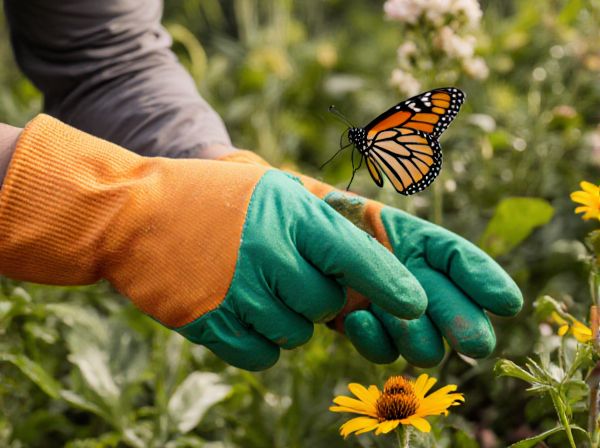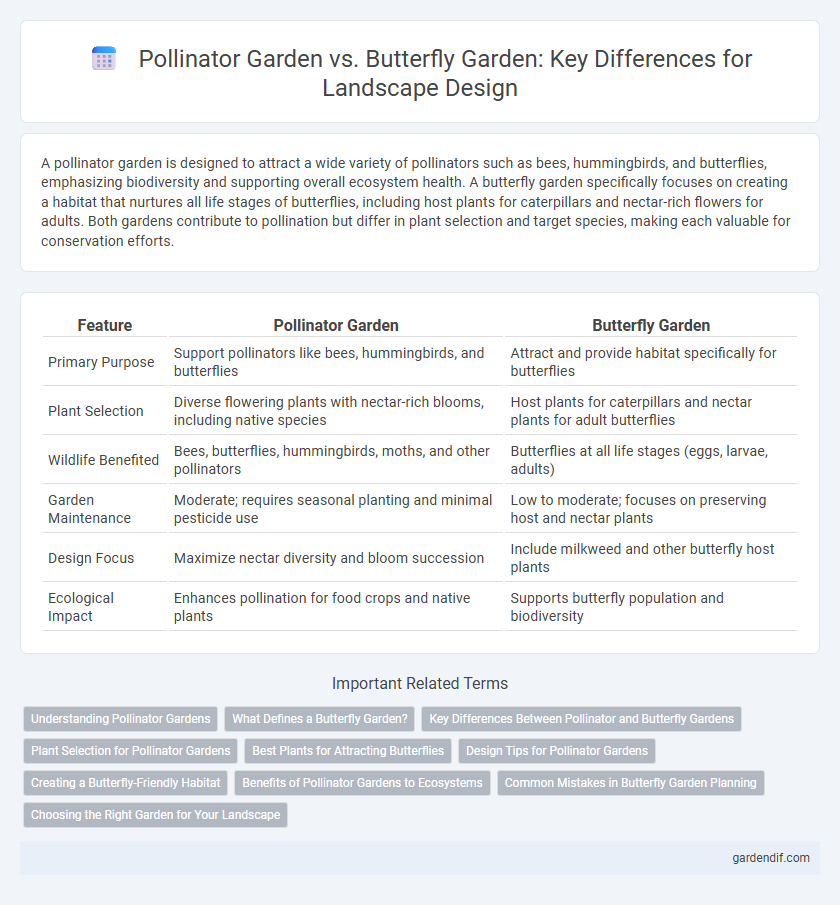
Pollinator Garden vs Butterfly Garden Illustration
A pollinator garden is designed to attract a wide variety of pollinators such as bees, hummingbirds, and butterflies, emphasizing biodiversity and supporting overall ecosystem health. A butterfly garden specifically focuses on creating a habitat that nurtures all life stages of butterflies, including host plants for caterpillars and nectar-rich flowers for adults. Both gardens contribute to pollination but differ in plant selection and target species, making each valuable for conservation efforts.
Table of Comparison
| Feature | Pollinator Garden | Butterfly Garden |
|---|---|---|
| Primary Purpose | Support pollinators like bees, hummingbirds, and butterflies | Attract and provide habitat specifically for butterflies |
| Plant Selection | Diverse flowering plants with nectar-rich blooms, including native species | Host plants for caterpillars and nectar plants for adult butterflies |
| Wildlife Benefited | Bees, butterflies, hummingbirds, moths, and other pollinators | Butterflies at all life stages (eggs, larvae, adults) |
| Garden Maintenance | Moderate; requires seasonal planting and minimal pesticide use | Low to moderate; focuses on preserving host and nectar plants |
| Design Focus | Maximize nectar diversity and bloom succession | Include milkweed and other butterfly host plants |
| Ecological Impact | Enhances pollination for food crops and native plants | Supports butterfly population and biodiversity |
Understanding Pollinator Gardens
Pollinator gardens are specifically designed to attract and support a wide variety of pollinators, including bees, butterflies, hummingbirds, and other beneficial insects, by providing diverse native plants, nectar sources, and shelter. Unlike butterfly gardens, which primarily focus on attracting butterflies, pollinator gardens enhance biodiversity and improve ecosystem health through a balanced habitat that promotes pollination for many plant species. Incorporating a range of flowering plants that bloom at different times ensures continuous food supply for pollinators throughout the growing season.
What Defines a Butterfly Garden?
A butterfly garden is defined by the deliberate selection of nectar-rich flowering plants and host plants that support the complete lifecycle of butterflies, from caterpillars to adults. Unlike general pollinator gardens, butterfly gardens prioritize native milkweed, violets, and other species that attract specific butterfly species for egg-laying and feeding. These gardens also provide sunny spots, shelter, and water sources essential for butterfly survival and reproduction.
Key Differences Between Pollinator and Butterfly Gardens
Pollinator gardens attract a diverse range of pollinators including bees, butterflies, hummingbirds, and other beneficial insects by incorporating a variety of native flowering plants that bloom throughout different seasons. Butterfly gardens specifically focus on plants that cater to the lifecycle of butterflies, providing nectar sources for adults and host plants for caterpillars. The key difference lies in pollinator gardens promoting broader biodiversity and ecosystem health, while butterfly gardens target the habitat needs of butterflies exclusively.
Plant Selection for Pollinator Gardens
Pollinator gardens prioritize a diverse mix of native flowering plants such as milkweed, coneflowers, and bee balm to attract a wide range of pollinators including bees, butterflies, and hummingbirds. Plant selection emphasizes continuous bloom cycles, nectar-rich flowers, and host plants that support multiple pollinator species throughout the growing season. Butterfly gardens focus more narrowly on butterfly-attracting plants like butterfly bush and lantana, but pollinator gardens create a balanced ecosystem benefiting broader pollinator populations.
Best Plants for Attracting Butterflies
Pollinator gardens feature a diverse range of flowering plants such as milkweed, coneflowers, and bee balm, which attract various pollinators including bees, butterflies, and hummingbirds. Butterfly gardens specifically prioritize nectar-rich plants like butterfly bush, lantana, and pentas that provide vital food sources for adult butterflies. Including native plants such as goldenrod and asters enhances butterfly habitat by supporting caterpillar host plants essential for their life cycle.
Design Tips for Pollinator Gardens
Pollinator garden design emphasizes plant diversity, incorporating native flowering species that bloom sequentially to ensure continuous nectar and pollen sources for bees, butterflies, and other pollinators. Incorporate host plants like milkweed and fennel for butterfly larvae, while providing shelter with layered vegetation and avoiding pesticides to create a thriving ecosystem. Position garden beds in sunlit, wind-protected areas and integrate water features to enhance habitat suitability and pollinator visitation rates.
Creating a Butterfly-Friendly Habitat
Creating a butterfly-friendly habitat involves planting nectar-rich flowers like milkweed, coneflowers, and butterfly bush that attract diverse pollinators, including butterflies. A pollinator garden supports a wide range of insects such as bees, beetles, and moths by incorporating native plants and providing shelter and water sources, while a butterfly garden specifically emphasizes host plants that cater to butterfly larvae needs. Prioritizing native species and avoiding pesticides ensures a sustainable environment for butterflies to thrive and complete their life cycles effectively.
Benefits of Pollinator Gardens to Ecosystems
Pollinator gardens support a diverse range of species such as bees, butterflies, hummingbirds, and other beneficial insects essential for pollination, which enhances plant reproduction and biodiversity. These gardens improve ecosystem resilience by promoting genetic diversity and providing habitat connectivity for wildlife. Maintaining pollinator gardens contributes to sustainable agriculture by increasing crop yields through effective pollination services critical for food production.
Common Mistakes in Butterfly Garden Planning
Many butterfly gardens fail due to the selection of plants that do not cater to the specific nectar and host plant needs of butterfly species, reducing their attractiveness and effectiveness. Overcrowding plants or planting non-native species can disrupt the local ecosystem and limit butterfly habitat suitability. Proper planning must incorporate native flowering plants with staggered bloom times and suitable larval host plants to support butterfly lifecycles and promote biodiversity.
Choosing the Right Garden for Your Landscape
A pollinator garden supports a diverse range of insects including bees, butterflies, and hummingbirds by planting native wildflowers and nectar-rich plants, enhancing overall biodiversity. A butterfly garden specifically targets butterfly species by incorporating host plants for caterpillars and nectar sources ideal for adult butterflies. Selecting the right garden depends on your landscape goals, whether fostering broad ecosystem health or creating a specialized habitat for butterfly populations.
Pollinator Garden vs Butterfly Garden Infographic

 gardendif.com
gardendif.com